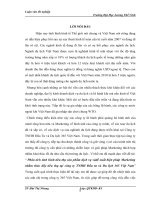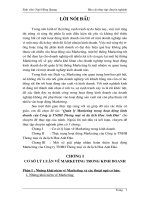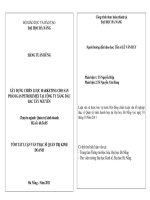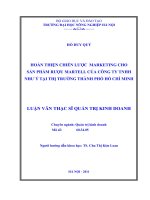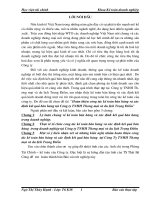PHÁT TRIỂN CHIẾN lược MARKETING CHO NHÀ HÀNG cơm VIỆT tại CÔNG TY TNHH TM DV và DU LỊCH TRẦN GIA e
Bạn đang xem bản rút gọn của tài liệu. Xem và tải ngay bản đầy đủ của tài liệu tại đây (483.13 KB, 73 trang )
PHÁT TRIỂN CHIẾN LƯỢC MARKETING
CHO NHÀ HÀNG CƠM VIỆT TẠI CÔNG TY
TNHH TM-DV VÀ DU LỊCH TRẦN GIA
DEVELOPING A MARKETING STRATEGY FOR VIET
RESTAURANT AT TRAN GIA COMPANY
TABLE OF CONTENTS
2
2
LIST OF ACRONYMS
Acronyms
Co., Ltd
Meaning
Company limited
3
3
LIST OF FIGURES
4
4
LIST OF TABLES
1. Introduction.
In times of open and integration with the region and the world, restaurant and
food catering services industry in Vietnam has seen many remarkable changes.
Restaurant system has made progressive advances. However, it is still an
uncomfortable fact that Vietnamese’ habit of using dining services and daily food
products is not appropriate and not hygienic. Besides, fierce competition among
restaurants, sidewalk food stall and beer restaurant has led to the situation of customer
scrambling, price increasing and food quality reduced. In addition, there are restaurants
which spend huge investment in brand promotion yet neglect of Vietnamese cuisine’s
core values.
With a population of over 80 million (chinhphu.vn), Vietnam ranks 15th among
countries with largest population in the world. Also, national living standard of
Vietnamese is increasingly improved thanks to with the growing economy. Nowadays,
holding a family dinner, company dinner parties, or a luxury wedding with Vietnamese
traditional style is not out of the reach to many people. Thus, the ambition of getting
rich from restaurant business starts to sparkle in many people’s minds.
Moreover, if a company wants to stay competitive, managing financial
capability, production and technology is not enough. It should also handle matters
concerning proper management and maximizing the effectiveness of Marketing Mix.
5
5
For companies in service industry, Marketing Mix system is particularly more
important.
In a desire to improve restaurant operation, satisfy customer demand and
enhance its competitiveness, the topic: “Developing a Marketing Strategy for Viet
restaurant at TRAN GIA COMPANY” has been chosen.
6
6
2. Research objectives
Based on marketing theories & knowledge and a scientific approach of research
methodology, the thesis aims to systematize theoretical basis on strategic marketing and
marketing mix.
The research has applied theoretical basis to conduct a profound analysis and develop
marketing strategy for Viet restaurant at Tran Gia Travel Services Trading Co., Ltd.
In addition, the thesis proposes a realistic and feasible marketing strategy and an action
plan to effectively implement marketing strategies for Viet restaurant at Tran Gia
Company
3. Research study and research scope
Research study: The thesis focuses on researching and developing marketing
strategy for Viet restaurant at Tran Gia Travel Services Trading Co., Ltd.
Research scope:
In theory: The thesis uses theories of marketing strategy, marketing mix and
strategic business management.
Besides, the thesis only analyzes Viet restaurant project at Tran Gia Company
4. Research Methodology
First, the author made a literature review of secondary data sources via searching
information in the textbooks, references, journals to understand about the market and
in-depth studies of marketing strategy. Data was collected from this source
Next, the author applied quantitative analysis through primary data sources. The
author conducted questionnaires survey with a sample size of 50. Participants were
asked about their assessments and comments on marketing strategy of Viet restaurant
The author used qualitative analysis on content of individual interview to obtain
necessary information to develop marketing strategy for Com Viet restaurant.
5. Thesis structure
Besides the introduction, tables, illustrated models, conclusion and references,
thesis content is structured into three chapters as follows:
Chapter 1: Theoretical basis
Chapter 2: Viet restaurant at Tran Gia Travel Services Trading Company limited
and real situation of developing marketing strategy
7
7
Chapter 3: Proposal of Marketing Strategies and Marketing Plan for Viet
restaurant
8
8
CHAPTER 1: THEORETICAL BASIS
1.1.
Marketing Strategy
1.1.1. Marketing Basis
According to Philip Kotler (2008), " Marketing is a social process by which
individuals and groups obtain what they need and want through creating, offering,
and exchanging products and services of value freely with others”. The core concept
concerns about the: needs, wants, demands, products, customer value and satisfaction,
transactions, market, marketing.
In modern view of marketing, marketing is defined as follows: "Marketing is the
process of working with the market to carry out exchanges in order to satisfy the needs
and desires of human being. It is also understood that Marketing is a form of human
activity (including organizations) in order to satisfy the needs and wants through
exchange. "(Tran Minh Dao, 2006)
Figure 1-1: Core basis of Marketing:
Need
Desire
Demand
Product
Marketing
Exchange transaction, relationship Satisfied expense value
Market
(Source: Philip Kotler, 2008)
Need: is a psychological condition when people feel deprived, want to consume, own a
good or service.
Desire: is a special form of need which is corresponding to the level of culture and
personality of the individual.
Demand: is need with accompanying condition of payment capability.
Product: is all that can satisfy desire or demand and is supplied in the market with the
purpose of attracting attention, purchasing or consuming.
9
9
The value of the consumer: is represented by the formula:
V=B/P
In which:
V: value of the consumer.
B: Consumer’s aware behavior.
P: Product’s value.
Transaction: is a trading exchange of valuables between two parties
Market: is understood as an open system in which there are presence of buyers, sellers,
and intermediaries to promote integration and implementation of the exchange of
money - goods to meet its needs.
Marketing: is human activity aimed at satisfying the needs and desires through
exchange.
1.1.2. The essence of marketing strategy:
Marketing strategy shows capability level, league and competitive position of
companies in the market.
When developing a marketing strategy, companies need to analyze their
situation including individual and organization’s capability, goals and surplus value to
individuals/groups/society. This analysis aims to understand the opportunities and
challenges that subjective and objective circumstances are bringing to the business.
Also, a general study of the company should be done to understand the company’s
strengths and weaknesses. A good marketing strategy should point out clearly how to
utilize opportunities with strengths, restrain threats and overcome weakness. Therefore,
it is analyzing competitive position of the businesses that contributes to make a good
marketing strategy.
1.1.3. Marketing strategy characteristics
Consistency: marketing strategy must be consistent with general development
trend of the enterprise and is the orientation for overall operation of the company.
Marketing strategy must go in line with the development trend of the market.
1.2.
The process of developing a marketing strategy:
In International Conference on “Marketing for new era” hosted by educational
PACE consortium in 2007 in Ho Chi Minh City, Vietnamese entrepreneurs had the
10
10
chance to listen and learn so much from the father of the modern marketing theory.
Quotes from his speech:
- Let's focus on clients first, employees next, thirdly partners and finally
competitors.
- Do not think that marketing is just about advertising and sales.
- Use your market research to orient marketing strategy in long term.
- Focus on a market niche where you can provide a higher value through
differentiation and appropriateness.
- Avoid price deduction to protect market share. It is better to increase
benefits for the customer instead of discounts.
In theory, marketing strategy presents the first overview of various marketing
elements and how to utilize to achieve marketing goals.
The figure below shows clearly some important points when developing
marketing strategy
Figure 1-2: The process of developing a marketing strategy
11
11
12
12
(Source: Tran Minh Dao (2009)
Implementation and
•
testing
Conduct a strategic marketing plan as proposed, at the same time, always keep track of market developments to be
able to make adjustments promptly and reasonably.
Planning marketing
•
Make sure to focus on a single idea within a certain period of time when writing Makerting strategy. The strategy
programs
should describe specifically and focus on how to use the tools in the 7P Marketing Mix. Make SWOT analysis
with the market research tools to achieve other marketing objectives.
Setting up marketing
•
strategies
Consider positioning strategy. This is the product image that the company wants to convey to the mind of targeted
market relating to competitors.
Segmentation & target
•
Consider target market and marketing objectives. Reassessing the challenges and opportunities, note on how to
market selection
solve the problem and take advantage of opportunities. The decision of the idea will form strategies to achieve
business goals.
Analysis of marketing
•
opportunities
Comment and evaluate opportunities, targeted market challenges. Note on the ideas available about how to solve
problems and utilize opportunities.
1.3.
Marketing Mix strategy
1.3.1. General basis of Marketing Mix system:
1.3.1.1.
General basis of Marketing Mix:
According to Philip Kotler (2007), "A Marketing mix is the mixture of
controllable marketing variables that the firm uses to pursue the sought level of sales
in the target market”.
Marketing Mix includes everything that a company can use to influence on the
demand for their goods. Marketing mix includes five tactical marketing tools: product,
price, place, promotion and people, and in some cases there is additional components,
which are people, process and physical evidence
Figure 1-3: Marketing Mix
Product
Price
People
Marketing Mix
Promotion
Place
(Source: Philip Kotler, 2007)
1.3.1.2.
Marketing Mix system in restaurants:
Regarding business operation in general and restaurant business in particular,
marketing mix strategy system shows the relationship between companies and business
environment, market, customers and competitors. It includes specific strategies for
targeted markets, for Marketing Mix and marketing costs.
From above point of view, we can generalize and systematize Strategic
Marketing Mix system as follows: marketing strategy of a company is required to cover
13
13
entire targeted markets of the business. For each targeted market segment, an effective
Marketing Mix strategy can developed by changing the combination of 7P (Price,
Place, Produce, Promotion, People, Physical Evidence, Process) to match with the
fluctuation and actual circumstances in each targeted market..
1.3.1.3.
Roles of Marketing Mix in restaurants:
Like many other businesses, restaurants also have to choose and solve basic
economic problems of restaurant operation.
It is necessary to identify the types of products and services that restaurants shall
supply to the market. Marketing department will help restaurant owners solve this
problem by conducting market research which might comprises of the following
activities: collect market information, study consumer behavior i.e. how customers use
products/services and select restaurants, identify needs for products and services of
individual and business customers as well as their changing trends, find out about
products and services which are available in the market etc.
• Organize the process of supplying products and services
• Handle harmoniously relationships between customer benefits, restaurant staffs
and owner’s interest.
Marketing becomes the bridge between restaurants and the market
• Marketing helps restaurant owners recognize market factors, customer needs, and
its fluctuation.
• Marketing helps restaurant owners orient and coordinate activities of all
departments and all staffs restaurant to better meet customer needs
Marketing contributes to the competitive position of the restaurant
To create competitive position, marketing department of the restaurant should
focus on solving major problems:
• It must create the uniqueness of products and services
• It must clarify the importance and advantages of the difference to customers through
campaigns, advertising.
• Ability to maintain the advantage of the difference.
1.3.1.4.
Market Segmentation:
Market segmentation is the division of the overall market into smaller market
segments. Each segment has different aspects, but customers in the same market
14
14
segment are relatively homogenous in interests, tastes, purchasing behavior, and
economic capability
Nowadays, as the economy develops, human being’s requirements are
increasingly diverse. A single good or service can not satisfy the needs of everyone. If
the enterprise wants to develop, it need to choose one or a few particular market
segments, research customer needs in that segment and design their products to meet
those customer needs.
According to Philip Kotler (2008) the market can be segmented as follows:
•
Market segmentation by geography: is dividing the market into different
geographical units such as nations, regions, provinces, cities, ... the company can
operate in one or a few geographical areas or all of these areas, but they need to pay
attention to the differences in the needs and preferences of each geographic region to
provide right product. In restaurant industry, this kind of market segmentation is pretty
clear. For example, Asian restaurant serves Asian cuisine; targeted customers are fond
of Asian food.
• Market segmentation by demography: A number of demographic criterion must be
included such as age, gender, family size, family life cycle, income, occupation,
education, religion i.e. These factors greatly influence the buying decisions of
customers. For example, a high-income earner tends to eat in restaurants more than the
middle and low income earners do. Businessman will be likely to visit restaurants more
frequently since they have to treat customer. The marketer therefore needs to carefully
study demographic matters to design the product which suits with each customer
segment
• Market segmentation by psychology: The psychological factors include lifestyle,
personality and social class i.e. upper class, lower upper class, middle class; lower
middle class, upper lower class, the lower class. The use of this criterion for
segmentation is very important. Those in the upper class are likely to be interested in
restaurant with impeccable services and pay little attention to price, whereas those in
the lower middle class and lower class will pay much attention to price before they
make buying decision. Those in the lower middle class and lower class are price
sensitive; a small change in price will make their buying decisions changed. In
15
15
restaurant business, the restaurant develops appropriate policies depending on targeted
audience,
• Market segmentation by behavior: The behavioral factors include reasons, benefits,
user’s status, loyalty, ready stage, attitudes towards products. Thorough study of
customer behavior is very important. Marketing people should know why customers
come to the restaurant, why they choose this restaurant over other restaurants etc.
Those questions are important basis to better understand the needs of customers so that
better products which are appropriate for them will be created
Based on the above market segment criterion, the restaurant’s segmentation
methods are as follows: Firstly, one-phase method, the restaurant uses a single criterion
for initial segmentation. Secondly, two-phase or more-than-two-phase segmentation,
after selecting a criterion for fundamental segmentation, the restaurant will continue to
use two or more criteria and other segment basis.
In restaurant business, market is usually segmented into two or more phases. For
example, customers of Asian restaurant with Asian cuisine are mostly Asian. It shows
that such restaurants did geographical segmentation. Besides, food price of that
restaurant is relatively high, aiming to serve high income earners. The restaurant has
followed demographic segmentation method.
1.3.1.5.
Selecting targeted market
The segmentation process has presented the company with opportunities. After
analyzing strengths and weaknesses in each of segment, the company must decide how
many phases to cover and what are the most appropriate one. This is a matter of
selecting key market.
To meet the market demand, according to Philip Kotler (2008), businesses can
choose one of three ways:
A: Irrespective Marketing.
Company’s Marketing
Market
B: Distinguish Marketing.
Marketing Mix 1
Area 1
Maketing Mix 2
Area 2
16
16
Marketing Mix 3
Area 3
C: Focusing Marketing.
Area 1
Marketing Mix
Area 2
Area 3
Source : Philip Kotler (2008)
1.3.1.6.
Positioning on the targeted market
When the company has decided to select a particular market segment, the
company must also decide which position to occupy in that market segment. The
position of a product and service is determined by the level of customer recognition
compared to peer products and services of other competitors. Successful positioning
will make customers easily identify the difference, and they will see what they are
looking for. It also allows businesses to exactly identify opportunities in the market.
Marketing professionals can apply some of the following strategies:
• Positioning based on specific attributes of the product.
• Positioning based on needs and interests.
• Positioning for specific use.
• Positioning on client type.
• Positioning on other products.
• Positioning by creating product differentiation.
17
17
1.3.1.7.
Product
Product policy plays an important role in marketing strategy. It is the orientation
for all business activities of the company. To ensure effective operation, product policy
can now be built based on following factors i.e. business strategy and business plans of
the company, market needs and the company’s capability
Product policy includes the following elements:
• Determine width: is the total number of product/service categories in the
product/service portfolio of the enterprise
• Determine length: is the total number of products/services in each category.
• Determine depth: is the level of specialization in each products/services in
business plan corresponding to different strategies.
• Determine the level of homogeneity: is the closeness, unity, similarity among
products.
• Development of new products: new product development is essential since
customers' needs are constantly changing, requiring companies to timely
respond to such changes.
1.3.1.8.
Price policy
Price is not the leading factor in competition, but it has always been considered
an important factor in attracting customers, especially in markets where residents have
low income. In a competitive market, the restaurant must have appropriate pricing
policy in order to create a firm position in the market. Price policy is considered to be
the most effective in attracting customers, generating sales and determining
profitability of the business. The pricing will depend on the characteristics of targeted
customers and time. A number of restaurants have pricing policy, which is contingent
on seasons, holidays, and weekends. For example, in the winter, when the restaurant is
quiet, many restaurants will offer discount to attract customers. As such, to build an
effective pricing policy, the company needs to obtain a complete overview and takes
into consideration following factors such as prices, exchange rates, discounts etc.
Some goals when developing pricing policy:
• Maximize Profit: This target is usually set out with reputable large corporations
which have good quality products and services. The price is usually higher than
the average of the same class
18
18
• Dominate the Market: In the early stages of market penetration, enterprises need
to secure a position, hence many choose to set prices equal to or lower than the
average to approach market easier. However, that price will change to ensure
long-term profitability.
• Be leading in quality: For businesses that their quality of service has reached
professional level or unique peculiarities, the price is usually higher than their
competitors in order to confirm product quality and corporate brand.
• Skim pricing: when the enterprise releases a new product, it is priced high to
skim off the lucrative part of the market, the price will be lowered later on
• Pricing with survival goals: When the competition is fierce, companies are in
trouble, or when the product is in saturation or in recession stage, companies
often apply low-price policy to increase competitiveness and lengthen product
life cycle.
Common pricing methods in restaurant business:
• Psychological pricing
• Cost-plus pricing.
• Target pricing
• Competitive pricing
Price is the most flexible factor expressing relationship between supply and
demand. It immediately affects consumers, competitors as well as the profitability of
the company. Hence, pricing and price behavior is particularly important in the
business operation. Price depends on many factors, of which companies must study
when set the price, i.e. goals of the pricing (sales volume and profitability), the
company's capability (the ability to gather suppliers, market condition forecast),
capability of competitors, market elasticity and subtitutes product.
Figure 1- 4: Factors influencing pricing
Internal factors
- Marketing goals
- Marketing Mix
- Cost
- Pricing department
External
Commercial
pricing factors
decisions
mại
- Market nature and demand
- Competition
giá
thương mại
- Other environmental factors: Economy, Politics, Society
19
19
Source : Collected
Some pricing policies that the restaurant should notice:
Competitive Pricing: The restaurant sets prices corresponding to the price of
competitors.
Target pricing: This method does not make sense in free competitive market.
The process begins with determining the desired profit earned when making
investment decisions. Based on return on investment (ROI), the restaurant will
be able to perform financial calculations to determine the price.
Cost-plus pricing: This pricing method begins by estimating demand. Based on
the estimates, average cost per unit is calculated. Interest is added to the average
cost per unit of production and the total is the selling price shall be the sum of
average cost per unit and profit
1.3.1.9.
Place policy
Distribution strategy is the way companies provide its products and services to
customers in targeted market. It includes a combination of networks, distribution
channels;
Distribution strategy plays a highly important role in business operations, which
facilitates the flow of products from producers to consumer. For producers, the type and
number of intermediaries in the sale of products/services are the first factors that need
consideration when developing distribution strategy.
Depending on the form of market, product characteristics and customer demand,
product prices, restaurants and food outlets can select and apply one of the following
three strategies:
• Strong distribution strategy.
• Selective distribution strategy.
• Privilege strategy.
Issues related to the distribution operation in service:
20
20
• Standards achieved in service distribution: Accessibility, availability
• Important role of direct distribution in service
• Selecting distribution channels
• Strong distribution strategy.
In service marketing, the role of direct distribution is important because:
• The particular nature of services is: inseparable, therefore it can not be
transported; perishable (can not be withered, can not be put in storage),
• Improve media management capability with targeted customers: Due to direct
marketing, restaurants have a direct relationship with customers, it is possible to build
customer database.
• Improve service & customer care: direct marketing helps restaurants manage ,
control directly on service delivery operations and direct relationship with customers
• It also helps to improve the reliability of consumption since customer
consumes products/services directly from the manufacturer.
1.3.1.10.
Promotion policy
In current market mechanisms, promotion policy plays an important role. It
increase
customer awareness
of the company,
remind customers Promotion
of products/services
Influence
Sequence
Promotion
goals
tools
and keeps customers updated about new products/services of the company
Awareness
Knowledge
Provide information
Recognize brand Advertisements.
Provide brand’s knowledge
Sample development, trial use, promotion, displa
PR
cu
Interest
Favorite
Figure 1-5 : Promotion goals
Develop positive attitude
Establish visionary picture
Create difference
Build trust
Persuasive advertisement
PR
Individual sales
Encourage and maintain
Encourage
wants consumption.
Maintain purchasing behavior.
Reinforce attitude and trust
Reminding advertisement
Discount promotion
PR
Desire
Purchase
21
21
Source : Collected
To set up a media advertising strategies, the enterprise can apply a combination
of strategies such as offers, promotion, advertising, sales support, special promotion.
On the other hand, it must identify the subject, content, form, facilities and budget for
that strategy. In the strategy, following questions should be answered
- Who is the target?
- What does the content aim at?
- Which form will be chosen?
- Which media?
- When will it be launched?
- And finally, how much it should cost?
Each advertising strategy is aimed to attract customer's attention so they would
be interested and decide to purchase. Besides, it also has to point out media channel and
forms of advertising. Advertising strategy should also include advertising content,
advertising time, quality control and evaluation of advertising.
In media advertising, it is necessary to pay attention to a number of factors that reduce
the effectiveness:
•
Give unrealistic commitments or exceed the capacity of providers
22
22
•
Do not understand or misunderstand the needs of customers.
•
Lack of knowledge and customer service experience.
•
The coordination and consistency between staff of the supplier are not high.
In addition, advertising strategies should determine advertising budget, a number of
methods to determine are:
•
Method of determining based on the percentage of the total sales.
•
Method of cooperation with the advertising agency.
•
Method of determining based on profit.
1.3.2. Additional components of the Marketing Mix:
1.3.2.1.
People policy
In any business, especially in restaurant business, people factor plays an
important role and determines the performance of the enterprise. In the restaurant
business people factors include: employees and customers.
Since people factor and people interaction play important roles in the
consumption and provision of service process, hence the socio-cultural factor is
important in determining customer behavior and services supply. Social and cultural
factors influence the way customers use and evaluate services, affects the way how
companies and employees interact with their customers.
The role of employees in service provision:
• Employees providing services are a part of the service.
• Present the company's image in the eyes of customers.
• Directly interact with customers.
• Direct impact on the perception and satisfaction of the customers.
• Create long-term and persistent relationships with customers.
•Be the information channel, provide assessment for the process of providing
service internally.
The role of the customer in the service providing process:
23
23
• Customers have a high level of participation in the process of creating and
distributing services: Because services can only be created with the appearance of
customer consumption, customers have the right to distribute their own services .
• Individuals or group of customers can increase or decrease the impact of
satisfaction level of the individual or other customer groups (the interaction of
the two groups of customers).
Table 1-1: Influence of customers to service provision
Positive
The appearance (celebrities, familiars…)
Personal
relationships
Negative
Complaints about service quality
(familiar, Crowded and noisy group of customers
acquaintance, partners)
Cultural, life style dissonance
Personalities (active, friendly…)
Misbehavior
Word of mouth
1.3.2.2.
Physical evidence policy
To survive and grow, any businesses, not just restaurant business, should always
have physical assets (product facilities). Business facilities includes all material means,
database used to produce the entire products and services. The investment on physical
assets reasonably can on one hand help the restaurant attract customers, is the tangible
condition to help reduce risks for customers , customers will find a peace of mind using
the products and services of the business. On the other hand, modern physical product
is the condition to improve product quality as well as working conditions and
productivity of colleagues. Technical infrastructure is critical conditions for businesses
to develop restaurant business.
In the process of products and services consumption, customers always consume
simultaneously physical products and the feeling for tangible product quality also
affects the level of satisfaction with the services, tangible elements include:
• Infrastructure.
• Features, design characteristics (luxury, matching lifestyle and status ...).
• Technologies and techniques (quick, convenient, high quality ...)
• Sense of art (eye catching, attractive ...).
• Culture (appropriate).
24
24
1.3.2.3.
Process policy
Service provision process to customers need standardization and always be flexible
depending on demand, situations ... The process steps are simple or complex will
depend on the level of participation in the processes of customers. Each different
enterprise and different business activities will have different processes of providing
services and the selection process depends on the owner of that business.
Figure 1-7: Marketing Mix Model
Source: cns-media.vn
1.4. Analytical tools:
This thesis analyzed, as mentioned above, using the Marketing Mix tool. In
addition, to understand the macro, micro environment and indirect or direct impacts to
the restaurant business, I have used a number of analytical tools such as BCG (analysis
of the appeal), 5 forces (competitive environment analysis) to provide comprehensive
assessment and overall picture of the operational elements of the Marketing Mix in the
restaurant.
1.5. Research methodology:
1.5.1. Selection of research methodology:
To implement the project and answer research questions, first of all, the author
selected qualitative methods of analysis with data from primary sources. The author
selection of primary data sources is to gather information directly to resolve the issues.
25
25

